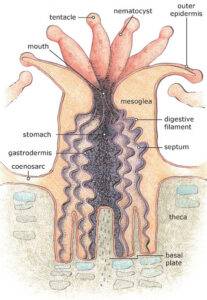We’re continuing our journey to the depths of the Blake Plateau and its fascinating deep-sea coral ecosystem by diving into the biology that makes deep-sea corals so unique. No need to have a background in biological sciences, just your excitement for all things Under the Sea is required!
The remote operated vehicle, Deep Discoverer, launching from Okenos, on the second dive of their 2019 expedition.
Image Credit: National Oceanic and Atmospheric Administration (NOAA) Office of Ocean Exploration
What are corals?
Let’s address a common misconception: corals are animals, not plants. Corals are colonies of several hundred thousand tiny individuals, known as polyps. Each polyp is its own animal. Corals are related to jellyfish and they are members of the phylum, Cnidaria (pronounced nuh-dare-ee-uh). Animals in the phylum Cnidaria have radial symmetry, no brains (also known as a central nervous system), and no bones! Both jellyfish and corals have stinging cells on their tentacles, known as nematocysts, that help them capture their food. Corals use their tentacles to wave food particles in the water column toward their mouth to eat them. This strategy of filtering food in the water column is known as filter feeding. Oysters are also filter feeders!
The anatomy of a coral polyp.
Image credit: NOAA
There are two main types of coral colonies: soft corals and hard corals. The main difference between the two types lies in how they build their colony and reef structures. Hard corals build calcium carbonate exoskeletons that gives them a rigid and rock-like appearance. Alternatively, soft corals are held together by soft squishy bodies and spines, known as sclerites. Both soft and hard corals can be found in either shallow water or deep-sea environments.
Hard elkhorn coral on the left, and a soft mushroom coral on the right.
Image Credit: NOAA Ocean Exploration
Deep-sea versus shallow water; what gives?
If you were to close your eyes and conjure up an image of a coral reef, you would probably imagine crystal-clear water and corals with bright colors. These shallow water corals are what most people are familiar with. They come in many vibrant colors and are often seen while snorkeling at the surface. Shallow water corals often live in the photic zone, or where sunlight can penetrate through the surface of the ocean.
The water close to the surface is often nutrient-poor, and the corals that live here struggle to get all of their necessary energy from filter-feeding alone. Thus, these shallow water corals have formed a beneficial relationship with a photosynthetic algae, known as zooxanthellae (prounounced zouh-zan-thel-luh). These algae, like plants, convert sunlight to create a food source. Some of that food source is given back to the corals that aren’t able to gather enough nutrients themselves, and in turn, the algae get to live safely inside the coral, protected from predators. Zooxanthellae can come in many different colors and is often what gives shallow water corals their bright color!
A shallow-water coral reef and some fish inhabitants in Palmyra Atoll National Wildlife Refuge.
Image Credit: U.S. Fish and Wildlife Service
Unlike their shallow water counterparts, deep-sea corals do not rely on photosynthetic algae for energy. Deep-sea corals live far beneath the surface, where no sunlight can penetrate, and no photosynthetic organisms can survive this deep. Luckily for the deep-sea corals, nutrients in the deep are plentiful, and they can get all the energy they need to survive through filter feeding. Deep under the surface, nutrients fall in the form of marine snow–or decomposing “bodies” of algae and zooplankton–from the surface. Marine snow is the bottom of the food chain in the deep ocean, and ultimately provides all the necessary energy for life to survive without light from the sun. Deep-sea corals are effective at taking these falling bits of decomposing matter and turning it into usable energy.
What color are deep-sea corals?
Although deep-sea corals don’t have the relationship with algae that gives shallow-water corals their bright coloring, deep-sea corals can come in many different colors! The color from deep-sea corals can be attributed to their diets.
Deep-sea corals can come in many different colors, including the pink, yellow, and red hues seen here.
Image Credit: NOAA Office of Ocean Exploration and Research
In addition to coming in a variety of striking colors, deep-sea corals can also be naturally white! Lophelia pertusa is a species of deep-sea reef building stony corals that are white. Commonly known simply as Lophelia, these white corals build massive reef mounds that shape the sea floor.
Large reef building stony coral, known as Lophelia pertusa, are naturally white!
Image Credit: NOAA
What do deep-sea corals in South Carolina look like?
Off the coast of South Carolina, Lophelia reefs scatter the sea floor, and provide habitat to hundreds of deep dwelling species. These reefs were newly discovered in 2018-2019, such as the Stetson-Richardson Reef Complex, which contains the world’s tallest coral mound, as known as a lithoherm. You can find a map of the known deep-sea coral reef complexes below.
A map of deep-sea reef features along the Blake Plateau.
Image Credit: Natural Resources Defense Council
What’s next?
Scientists are still exploring and categorizing their findings about the deep-sea Blake Plateau habitat. We’re continuing to share results and findings from the recent NOAA Expeditions to the Blake Plateau through our deep-sea corals blog series. Follow along with us and test your knowledge at our upcoming under the sea trivia event in February. More information about the trivia event to follow!







